|
|
Blandford

|
|
 |
|
|
The story of Blandford is about a horse whose career as a breeding stallion far exceeded what he accomplished on the racecourse, in many ways similar to the racing and breeding careers of stallions like Danzig and Mr. Prospector. Blandford proved himself as one of the most important classic sires of the Twentieth Century, and one of the most significant sires of sires on an international basis. He remains one of only four stallions to have sired four winners of the Epsom Derby, after Waxy, Sir Peter Teazle, and Cyllene.
Blandford was a product of the famous Tully Stud of Col. William Hall-Walker just outside of Kildare in Ireland. From 1900 to 1915 Hall-Walker bred classic winners Minoru (2,000 Guineas, Derby), Cherry Lass (1,000 Guineas, Oaks), Prince Palatine (St. Leger and Ascot Gold Cup twice), Night Hawk (St. Leger), Witch Elm (1,000 Guineas), and other high class runners including White Eagle, Royal Realm, Let Fly, Charles O'Malley, Challenger II, Great Sport, Black Arrow and Carrickfergus.
Hall-Walker was unique in that he utilized astrology in his stud, for better or worse, and many would place him in the category of "lunatic fringe" if it weren't for his record of success. From the moment of each horse's birth, the colonel would work up its horoscope, keeping those destined for greatness, and selling those who were not. His method has its flaws, obviously, since Prince Palatine slipped through that selection process and was sold, becoming one of the greatest horses Hall-Walker ever bred.
In 1916, during World War I, seeing a need to improve the country's cavalry program, Hall-Walker made a gift to the British government of his thoroughbred horses, including stallions and broodmares valued at $370,000. The government, in turn, purchased Hall-Walker's properties, Tully Stud in Ireland, and a training stable at Russley Park in Wiltshire for $325,000, and gave him the title of "Lord Wavertree" in recognition of his gesture. This property and these horses became the first National Stud for Great Britain. In 1943, the National Stud was moved from Ireland to England, the Tully property then becoming the Irish National Stud in 1945.
Among the horses given to the government in 1916 was a four-year-old bay filly named Blanche, by White Eagle out of Black Cherry by Bendigo. Although she was unplaced in ten starts at two and three, Hall-Walker had thought highly of her. In his 1916 "Gift to the State," a bound volume listing the horses and their accomplishments, he noted that Blanche ran "well up in good company," even though she never finished in the money in the top stakes in which he entered her: the Coventry Stakes, Cheveley Park Stakes or Oaks Stakes.
Blanche's sire was White Eagle (1905 by Gallinule - Merry Gal by Galopin), a Tully-bred who was also gifted to the National Stud program. One of the best two-year-olds of his year, at three, he won the Sussex Stakes and Duke of York Stakes among his five stakes wins, and placed in the St. Leger and 2,000 Guineas at three. At four, he won the City and Suburban Handicap, Atlantic Stakes and ran second in the Coronation Cup. He was a useful sire, getting Irish 1,000 Guineas winner Flying Dinah and Champion Stakes winner Let Fly, but his real reputation came as a broodmare sire. Besides Blanche, his daughters included the important broodmares Dolabella, Lady Peregrine, Quick Thought, Arctic Night, Widow Bird and Compromise.
Blanche's dam, Black Cherry, a daughter of the good handicapper Bendigo, had already produced the classic filly Cherry Lass (1902 by Isinglass), winner of the 1,000 Guineas, Oaks, St. James's Palace Stakes and Nassau Stakes at three; and dam of stakes winner Absolute (1901 by Gallinule). Black Cherry had also foaled the good colt Black Arrow (1903 by Count Schomberg), winner of the Coventry Stakes at two and St. James's Palace Stakes at three; and Jean's Folly (1901 by Ayrshire), winner of the Railway, Anglesey Stakes and Waterford Testimonial Stakes at two, and already dam of St. Leger winner Night Hawk (1910 by Gallinule).
Black Cherry was herself a half-sister to the good runner and important but short-lived sire Bay Ronald (by Hampton - Black Duchess by Galliard), sire of Bayardo, Dark Ronald, MacDonald II and the mare Rondeau (dam of Teddy). It's possible that Bayardo's pedigree influenced Hall-Walker in sending Black Cherry to White Eagle to get Blanche, since Bayardo's dam, Galicia was by Galopin out of a mare by Isonomy, the reverse cross as found in White Eagle, who was by Gallinule (by Isonomy) out of a mare by Galopin.
Blanche did not let the National Stud down as a broodmare. She produced 12 foals, six winners, led by stakes winners Blandford and Seminole. Blanche's daughter Nun's Veil (by Friar Marcus) produced the great race filly Sun Chariot and her half sister Calash, ancestress of Carrozza, Santa Claus, and Matahawk. Another daughter Blanc Mange (by Hainault) produced Selim Hassan, a leading sire in Argentina.
It's through Blandford, her 1919 colt by Swynford, that Blanche gained lasting fame as a broodmare. Blandford was from the third crop sired by Swynford (1907 by John O'Gaunt - Canterbury Pilgrim by Tristan), one of the greatest runners bred and raced by Lord Derby. A younger half-brother to Derby's good runner and sire Chaucer, Swynford was a fabulous racehorse, humiliating Derby winner Lemberg when he ran away with the St. Leger Stakes and coming back the next year to continue his rivalry with that colt, ending the season with victories including the Eclipse Stakes by four lengths, before breaking down badly in a morning gallop. The Hon. George Lambton was of the opinion that Swynford was the best horse he ever trained. Swynford's first crop, foals of 1914, included the useful colt Hainault, a stakes winner in 1917. His second crop included the 1918 1,000 Guineas winner Ferry, and her performance may have been the driving force behind sending Blanche to Swynford in the spring of 1918.
Blanche foaled a brown colt by Swynford on May 26, 1919. He had a large star on his forehead, and his left front fetlock was white. He had more refinement and class about him than his sire, Swynford who was a big, plain horse, so the exquisite quality of White Eagle may have been making itself known through his daughter Blanche. A great bodied colt, he unfortunately grew to be very short and upright in his pasterns, and stood over at the knee to a marked degree. These conformation flaws can be tracked on both sides of his pedigree. Swynford's sire John O'Gaunt was an unsound horse who sired unsound horses, and was described as having "bad feet, round joints and pasterns that were very upright." Black Cherry was a half-sister to Bay Ronald, who was noted for being over at the knees, as was Galopin who appeared three times in Blandford's pedigree, through John O'Gaunt, White Eagle, and Black Duchess. These conformation flaws strongly suggested soundness issues down the road for Blanche's brown colt, although he seems to have been a very well made individual in all other aspects on his conformation.
The Swynford colt almost didn't get to find out one way or the other. During his yearling year, a strange scenario unfolded when several carthorses somehow broke into the youngster's paddock. In the ensuing ruckus, the colt was knocked to the ground and nearly trampled to death. Although no bones were broken, he was so body sore and bruised that he could not stand and had to be fed by hand. The condition led to him developing pneumonia, and the story goes that the colt was in such a wretched state that the director of the National Stud, Sir Harry Greer, offered him as a giveaway to the veterinary surgeon on the case just to get him off the grounds. The vet, not seeing the bargain being offered, turned down the gift.
Gradually Blanche's colt recovered, but not in time to sell at the chosen venue the 1920 July Sales at Newmarket. Instead, he was entered in the Newmarket December Sale, where he drew the attention of the brothers Samuel C. and Richard C. Dawson. Sam Dawson remembered the sale well, since it represented a monumental point in his life. "I acknowledge my great, good luck in buying Blandford as a yearling. I was commissioned by that good judge, Col. F.F. McCabe, to buy him, if possible, for a stated sum. The horse went considerably beyond what was expected, and, liking him myself, I bought him for his present job at what proved a small sum..."
Richard "Dick" Dawson was an astute trainer. Since 1897, he had leased and developed a farm at Whatcombe, near Wantage, in Oxfordshire into one of the finest racing stables and gallops in the world. His first year there, he trained Drogheda to win the 1898 Grand National Steeplechase, and the year before his landmark purchase of the Swynford - Blanche colt, he'd trained the filly Fifinella to win both the 1919 Oaks and Derby. With the new patronage of the Aga Khan, Whatcombe was undergoing a revival. Dawson would be the leading trainer in Britain for 1916, 1924 and 1929; and he ultimately trained the winners of 10 classic races including four Epsom Derbys, three St. Legers, one 2,000 Guineas and two Epsom Oaks.
At the 1920 December Sales, the Dawson brothers looked past his faults, saw the potential and went to 720 guineas to get the Swynford colt and sent him to Whatcombe for his training. Near Whatcombe, there's a medieval market town, Blandford Forum, and it's likely they named the colt after the village. Blandford's pedigree works well with name, being by Swynford out of Blanche.
Blandford on the Turf
Trainer Dawson thought well of Blandford from the start, although his leg issues made him a challenge to keep sound on a day-to-day basis. "I tried Blandford very highly in June as a two-year-old; he gave 23 pounds to a filly called Malva. The filly was already a winner and the fact that Dawson put 23 pounds on Blandford to make the trial a fair exercise speaks volumes (Malva was Blandford's future mate in the production of Derby winner Blenheim II). Blandford made his first start at Newbury in the five furlongs Kennet Plate, which he won with ease over a good colt named Scamp, who went on to win the New Stakes and Gimcrack Stakes. Blandford ran back a week later in the Windsor Castle Stakes at Royal Ascot, and closed gamely within a neck of the winner Alaric, although he stumbled in the last few yards, already going lame from the effort. He was done for the season and wasn't seen under silks for the better part of a year.
Despite this brief showing, two starts in a week's time, Blandford was rated the joint-third best colt with Condover, Polyhistor and Scamp, all more accomplished colts, all assigned 121 pounds, and within five pounds of the juvenile high weight (126 pounds), a filly, Golden Corn who had won the Middle Park Stakes and Champagne Stakes.
Wisely, Blandford had not been nominated to the Spring classics. The 2,000 Guineas was won in his absence on a drenched racecourse by St. Louis, with Pondoland second and the heavily favored Captain Cuttle third. Blandford made his three-year-old debut later in May of 1922 in the Paradise Stakes, a mile and a quarter event at Hurst Park. He won easily, beating Captain Fracasse and Spike Island. Spike Island was an improving colt who went on to win the Irish 2,000 Guineas and Irish Derby.
Blandford was handled gently and not rushed back to the races as he had been the year before. In the interim, he was tested favorably in a trial with his well regarded four-year-old stablemate, Franklin. Franklin's next out was the prestigious Coronation Cup in June, which he won, and which Dawson used as a gauge for his continuing high opinion of Blandford. Captain Cuttle, in the meantime, won the Derby Stakes with ease, setting a new record for the mile and a half. Blandford returned to the racecourse in the Princess of Wales's Stakes at the July Meeting at Newmarket and galloped out the mile and a half, finishing two lengths in front of Silver Image, a four-year-old.
Back home at Whatcombe, Blandford was moving forward rapidly but Dawson was having a devil of a time holding him together. At this point in their careers, the trainer felt he had a colt at least as good if not better than Captain Cuttle, but the two were never to meet. Captian Cuttle had followed up his Derby win with a victory in the St. James's Palace Stakes at Royal Ascot but the firm ground took its toll on the enormous Hurry On colt and he was put away for the rest of the year, to return as a four-year-old. One morning in July, Dawson sent Blandford out for exercise on the Far Sainfoin gallops at Whatcombe and the colt with infinite promise broke down badly, bowing both front tendons, just as his unfortunate conformation had predicted.
An attempt was made to bring Blandford back at four, but he was unable to make a start. After only four starts and three wins, he was retired to stud for the 1924 season at Cloghran Stud, just outside of Dublin, in Ireland, owned and managed by co-owner Samuel C. Dawson, trainer Richard Dawson's brother. Blandford initially stood for a fee of 148 guineas. He wasn't a particularly popular stallion at first - his unsoundness undoubtedly scaring them away - and he got few quality mares, but from that first small crop, foals of 1925, came the good two-year-olds ATHFORD and BULAND, which drew immediate attention to their sire.
First Runners
ATHFORD (bay colt, 1925 out of Athasi by Farasi) was bred by David Barnett, but raced by his brother William Barnett, a grain importer from Belfast. William had inherited his brother's bloodstock holdings in 1925 including the mare Athasi and her Blandford foal (ATHFORD), which he boarded at Cloghran Stud. Under the tutelage of Jack Rogers at Athgarvan Lodge on The Curragh, ATHFORD was considered the best two-year-old in Ireland after wins in the National Breeders Produce Stakes and Anglesey Stakes. |
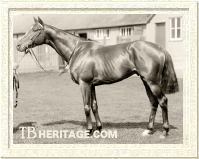
Athford
| |
Sent to England into the care of Richard Dawson at Whatcombe, ATHFORD won the Doncaster Cup and Kempton Jubilee as a four-year-old, but lost the Coronation Cup by a short head to the American invader Reigh Count after gaining the lead in the stretch. He also lost the Lincolnshire Handicap by another short head to Elton. At five, his best stakes effort was third in the Coronation Cup, won by Plantago. ATHFORD stood the 1932 season in Great Britain, after which he was sold to Japan. A photo of ATHFORD shows a horse of high quality very much in the mold of his sire Blandford, right down to being over at the knees. He had a long forearm, short cannons, great shoulder, and good length of hip, although his hocks were a little behind him. |
ATHFORD was the first of six stakes winners produced from the mare Athasi, who has to be considered one of the greatest broodmares in Irish breeding history. She had 14 foals, 10 winners and six stakes winners, all of those stakes winners being sired by Blandford. The year after foaling Athford, she produced TRIGO in 1926, who won the Derby Stakes and St. Leger Stakes. Her 1929 filly CENTENO won the Anglesey Stakes; her 1930 colt HARINERO won the Irish Derby and Irish St. Leger; her 1931 colt PRIMERO won the same classic pairing, the Irish Derby and Irish St. Leger; and her 1933 filly HARINA was a stakes winner and was later second dam of Derby/St. Leger winner Tulyar and Prix de l'Arc de Triomphe winner Saint Crespin.
Blandford's other first crop juvenile stakes winner was BULAND (colt, 1925 out of Saffian by Stornoway), winner of five races highlighted by the Imperial Produce Stakes (6f. Kempton), and Newmarket's Breeders Stakes.
Derby Sire
Blandford's second crop produced one of his best runners, and the first of four Epsom Derby winners. TRIGO (bay colt 1926 out of Athasi by Farasi) was the second result of William Barnett's mare Athasi mated with Blandford. His name means "wheat" in Spanish, as owner Barnett was a grain importer. Foaled at Cloghran Stud, TRIGO'S career initially mirrored that of his brother ATHFORD. He was trained by Jack Rogers in Ireland and won the Anglesey Stakes and Phoenix Plate, then was second to the good filly Soloptic in the Railway Stakes on a deep course, and third in Waterford Testimonial Stakes. He was ranked the best among Irish two-year-olds before being transferred to Dawson at Whatcombe as a three-year-old. Rogers knew what he was losing, as he told the head lad traveling with TRIGO, "Take great care of him. He's the best colt that has ever left Ireland." |

Trigo
| |
At three, TRIGO won the seven furlong Berkshire Handicap at Newbury, then put in a clunker in the 2,000 Guineas, won by the highly regarded speed horse Mr. Jinks. Overlooked in the Derby, TRIGO enjoyed the pelting rain better than any other, and won by a length and a half from Walter Gay, with Brienz in third, and Mr. Jinks out of the money. After a layoff, TRIGO returned in the St. Leger and won a desperate duel with Bosworth by a head. Sent back home to Ireland, he took his home country's St. Leger by a very short nose from Visellus. He retired from racing with six wins in 10 starts, and champion of his age group in both Ireland and England. |
|
BLENHEIM - known as BLENHEIM II in the U.S. - (brown colt 1927 out of Malva, by Charles O'Malley) was produced from Blandford's Whatcombe workmate Malva. |
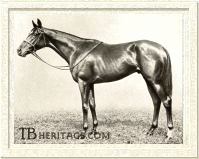
Blenheim
| |
Bred by Lord Carnavon, he was sold as a yearling for 4,100 guineas, purchased on behalf the Aga Khan by none other than Richard Dawson, who had trained both sire and dam, and sent to Whatcombe. BLENHEIM II was very similar in type to his sire, a medium sized colt of great quality and superb conformation; again, the only criticism was that he was a bit straight through his pasterns. At two, he won four of seven starts and was second in the other three. He wins included the New Stakes, and Hopeful Stakes, and seconds in the Middle Park Stakes (to Press Gang) and Champagne Stakes (to Fair Diana). He was rated fourth high weight among the two-year-olds behind Diolite, Press Gang and Challenger II.
|
At three, BLENHEIM II ran three times, winning the Derby by a length over Iliad, Diolite in third. He was unplaced in his season debut in the Greenham Stakes, and fourth in the 2,000 Guineas (won by Diolite). Training for the Eclipse Stakes, BLENHEIM II suffered a tendon injury and was retired with five wins from 10 starts. He was sent to the Aga Khan's French stud at Haras Marly La Ville, where he stayed through the 1936 season. BLENHEIM II's second crop included the Aga Khan's 1936 Derby winner Mahmoud (who set a new stakes record) and Blue Bear (French 1,000 Guineas), and his third crop included the Italian champion Donatello II. BLENHEIM II was sold over the summer of 1936 to an syndicate headed by Arthur Hancock and stood his first American season at Claiborne Farm in Kentucky in 1937. He was an immediate success in America, with his first crop producing the American Triple Crown winner Whirlaway. His other top class runners included the 1947 Kentucky Derby winner Jet Pilot, champion mare Mar-Kell, Kentucky Oaks winner Nellie L. and American Derby winner Fervent. In all, BLENHEIM II sired 60 stakes winners and was the Leading Sire in the U.S. in 1941.
BLENHEIM II continued Blandford's male line with strength. His son Mahmoud was imported to the U.S. for the 1941 season was the Leading Sire in America in 1946, and Mahmoud's son Afghan II was a Leading Sire in Chile. Donatello II had two sons who became leading sires in Great Britain - Alycidon (in 1955) and Crepello (in 1969). BLENHEIM became a great broodmare sire, and his most important daughter was Mumtaz Begum, dam of the multiple Leading Sire Nasrullah, and second dam of another great sire in Royal Charger. In America, daughters of BLENHEIM II became part of the formula for the great success of Calumet Farm, which owned 25% of the BLENHEIM II syndicate.
It had become apparent that Blandford was a superior classic sire, passing on the stamina required to win racing's biggest prizes. His progeny's average winning distance was close to 10 furlongs. Blandford tended to be siring small to medium-sized offspring with outstanding class and conformation, although more than a few had their sire's weak forelegs due to upright pasterns. Blandford was unfortunately not a vigorous breeding horse, and often took too much time to cover his mares. A mahogany bay himself, he was also pure dominant for bay or brown offspring, siring only a few grays and no chestnut offspring at all. |

| | Six Dams of Derby Winners Sent to Blandford in Ireland in 1931, Left to Right: Waffles, Felkington, Malva, Athasi, Una Cameron, Miss Matty |
The back-to-back victories of Trigo and Blenheim in the 1929 and 1930 Derbies now made Blandford one of the hottest commodities in the world. In 1931, his fee had risen to 400 guineas. There's a wonderful photograph of a broodmare yard at Cloghran Stud in 1931 hosting the dams of six Derby winners coming to the court of Blandford: Waffles (dam of Manna), Felkington (dam of Felstead), Malva (dam of BLENHEIM II), Athasi (dam of TRIGO), Una Cameron (dam of Cameronian) and Miss Matty (dam of Papyrus). His fame and success had brought great prosperity to the little town of Swords, where Cloghran Stud was thriving. The pub nearby was renamed "The Blandford Arms'" in tribute to their local hero, but all was not well on the home front in Ireland.
|
Blandford had been holding court in Ireland and many of Great Britain's best mares were coming to be bred to him, but politics, as always, tends to put a damper on a good time. In 1932, a new government took power in Ireland led by Eamon de Valera, and one of his most first acts was the repudiation of the Land Annuities that Ireland paid to the English Crown. This initiated an economic war in which England responded by establishing a 40% import duty on all agricultural products arriving from the Irish Free State, which nearly crippled Ireland, relying heavily on its exports. This duty included an ad valorem tax on bloodstock, so any Thoroughbreds sent from Ireland were heavily taxed to the point of making the voyage to visit Blandford prohibitive for English breeders.
The Dawson Brothers, as owners of Blandford, felt the pressure and transplanted their prize stallion to Richard's English training headquarters at Whatcombe Stables in Berkshire, where he stood his first English season at 400 guineas in 1933. The Dawson's loyal client, William Barnett, likewise transferred his bloodstock to England, purchasing Aston Park Stud in Oxfordshire in 1933 where he relocated Blandford's son TRIGO and TRIGO'S dam, Athasi, one of the bluest of Ireland's blue hens. |
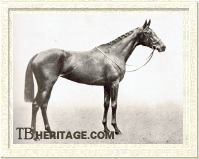
Udaipur
| |
Blandford's next crop to race was led by UDAIPUR (brown filly 1929 out of Uganda by Bridaine), bred by the Aga Khan, whose Irish stud, at Sheshoon, was a neighbor of Irish National Stud, where Blandford had been foaled. UDAIPUR was unraced at two, and bloomed at three to win four races including the 1932 Oaks Stakes, Coronation Stakes and Newmarket Oaks. As a broodmare she was outstanding, dam of four stakes winners: Umiddad (1940 by Dastur), winner of the Dewhurst Stakes and Ascot Gold Cup; Dust Devil (1946 by Stardust), winner of the Jockey Club Stakes and placed in the St. Leger; also Dharampur (1934 by Fairway), and Sonibai (1939 by Solario), the dam of Hindostan. UDAIPUR also produced the broodmare Clovelly (1938 by Mahmoud, so inbred 3x2 to Blandford), the dam of Irish 2,000 Guineas winner Claro.
|
|
The Aga Khan began to use Blandford extensively with significant success, including the purchase of the yearling colt Blenheim. Blandford's staying blood was a perfect foil for his speed-bred broodmare band. UDAIPUR was the first homebred of note by Blandford, although later ones would include MRS. RUSTOM, BADRUDDIN, UMIDWAR (a full brother to UDAIPUR), BALA HISSAR, and BAHRAM, who was still a couple years away. |
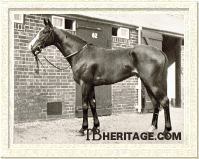
Harinero
| |
HARINERO (bay colt 1930 out of Athasi by Farasi) was the next star from that great broodmare Athasi for owner/breeder William Barnett. Unplaced at two, he won the Greenham Plate early in the season at three, but ran poorly in the 2,000 Guineas (to Rodosto), Derby and St. Leger (both won by Hyperion). Sent to Ireland, however, HARINERO ran to his family tradition by winning the Irish Derby (beating Shamsuddin by a length and a half) and Irish St. Leger (beating Golden Glen by a head), matching the feat set by his brother TRIGO four years before. At four, HARINERO won the Rosebery Memorial Plate and placed third in the Burwell Stakes (to Hyperion and King Salmon). He was sent to stud in Australia where he was only useful, getting 11 stakes winners including Trueness, Chaytor and Skip Bomber before his death in the early 1950s.
|
|
Blandford's 1931 foal crop was a formidable one and included three juvenile champions and five winners of eight classic races in England, Ireland and France. Star of the crop was WINDSOR LAD (bay colt 1931 out of Resplendent by By George!), bred by Daniel Sullivan in Ireland and purchased as a yearling for 1,300 guineas by the Mahraja of Rajpipla. Lightly raced and late developing at two, he ran twice without success early in the year, including a fourth to Colombo in the Richmond Stakes. Put on the shelf for several months, he returned with a hard-fought win by a head over Bright Bird in the Criterion Stakes in late October, his only victory from three starts. |
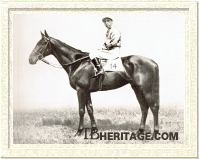
Windsor Lad
| |
At three, a bigger, stronger WINDSOR LAD dominated his age group, sweeping through the Chester Vase, Newmarket Stakes, and a particularly impressive win in in the Derby Stakes over Easton, with favored Colombo third. His reign of terror was broken by a third in the Eclipse Stakes against older horses, beaten by the older King Salmon and contemporary UMIDWAR (also by Blandford). At this point, the Mahraja sold WINDSOR LAD to Martin Benson for 50,000 pounds. The colt finished out the year with daylight wins in the Great Yorkshire Stakes, and St. Leger Stakes.
|
At four, WINDSOR LAD returned as champion, winning the Burwell Stakes by five lengths, the Coronation Cup by a length and a half, the Rous Memorial at Ascot, beating sprinters, and the Eclipse Stakes, over Theft and Fair Trial. He returned from the Eclipse Stakes with an injury that prompted his retirement with 10 wins from 13 starts and a reputation as a tremendously talented and courageous runner at all distances over all surfaces.
WINDSOR LAD retired to stand at Beech House Stud in Newmarket for the 1936 season at 400 guineas. Blandford had died in the meantime, leaving this outstanding colt his apparent successor and demand was strong. His health had taken a turn for the worse, however, and after several years of treatment, Benson asked for permission from Lloyds of London as the insurers to euthanize the horse after a sinus tumor had been diagnosed and fertility issues prevented him from a normal breeding career. The insurers paid off Benson and managed the stallion for two more years. When WINDSOR LAD was finally put down in 1943 at the age of 12, due to an intestinal aneurysm, he was in very poor condition and some thought his life had been prolonged inhumanely.
WINDSOR LAD still managed to leave a significant legacy. His 1939 crop included the Irish Champion Two-Year-Old and Triple Crown winner Windsor Slipper, who became a very successful sire for Brownstown Stud. WINDSOR LAD also sired the outstanding broodmare Phase, dam of six stakes winners including Oaks winner Neasham Belle, Champion Stakes winner Narrator, Yorkshire Oaks winner None Nicer, and classic-placed Netherton Maid. |
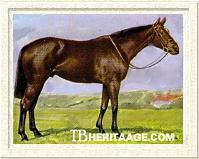
Primero
| |
While WINDSOR LAD was dominating the classic scene in England in 1934, his kinsman, PRIMERO (bay colt 1931 out of Athasi by Farasi), was doing the same in Ireland. Yet another of Athasi's get racing for William Barnett, PRIMERO won the Irish Derby in a dead heat with Patriot King, won the Irish St. Leger, and in England won the Great Northern St. Leger at Stockton. PRIMERO followed his brother Athford to Japan in 1935, and was a success there, getting Tosa Midori, Hakuryo, Cheerio and Katsura Shoho among his best runners before his death in 1955.
|
|
And while WINDSOR LAD and PRIMERO were dominating in England and Ireland, BRANTÔME (bay colt 1931 out of Vitamine by Clarissimus) was the king of France in 1934. Bred by Baron Eduoard de Rothschild at the famed Haras de Meautry in France, BRANTÔME was an older half-brother to the Grand Prix de Paris winner Crudite, also out of the mare Vitamine. A small, lightly made colt with a narrow blaze and three white feet, BRANTÔME was the champion of his crop at two in France, winning the Grand Criterium, Prix Morny and Prix Robert Papin. Returning at three, he breezed through successive wins in the Prix de Sevres by six lengths, Poule d'Essai des Poulains (French 2,000 Guineas) by three lengths, and Prix Lupin by two and a half lengths. Illness left him out of the Prix du Jockey Club and Grand Prix de Paris, but when he returned to competition in the Prix Royal-Oak (French St. Leger), he won by a neck from Astronomer. His grand finale of the season was a tremendous victory in the Prix de l'Arc de Triomphe, won by two and a half lengths over Assuérus and Felicitation. He was hailed a national hero. |
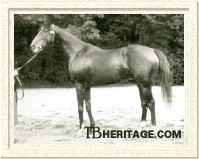
Brantôme
| |
As a four-year-old, BRANTÔME started with wins in the Prix Edgard Gillois, and then the Prix du Cadran. Entered in the Prix de Dangu, he bolted from his handler on his way to being saddled, galloped off and lost three shoes, so did not run and his training disrupted at a key time in his preparations for the Ascot Gold Cup. Sent to England despite this, he was not himself and ran fifth to Tiberius in shocking defeat in the Gold Cup. An easy win in the Prix du Prince d'Orange, BRANTÔME then ran another shocker, fourth in the Prix de l'Arc de Triomphe won by Samos, in which it was said he had gone wide and galloped over a marker on the course during the running. He retired with 12 wins from 14 starts, and entered stud at Haras de Meautry in 1936. |
Despite his stud career being interrupted by World War II and confiscation by German forces in 1940 for six years, BRANTÔME was a more than useful sire and left a long term impact in France. His most important was Vieux Manoir, winner of the Grand Prix de Paris, and his sire's successor at Haras de Meautry. Vieux Manoir was also the Leading Sire in France in 1958, and sire of future French leading sires Val De Loir and Le Haar. Le Haar's son Frontal was a leading sire in Germany. Vieux Manoir's son Mourne got another French Leading sire in Snob. BRANTÔME also sired Grand Prix de Paris winner, Pensbury; French Champion Two-Year-Old Dragon Blanc, who became an influential sire in Brazil; Brueghel, Coquelin, Abbe Pierre, and Caldarium.
|
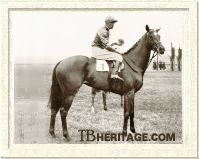
Campanula
| |
To round out Blandford's bumper crop of 1931 were the winners of the English and Irish 1,000 Guineas. Bred by Sir George Bullough's Longholes Stud, pretty little CAMPANULA (bay filly 1931 out of Vesper Bell by Pommern) was the highweight filly at two in England, following wins in the Windsor Castle Stakes at Ascot and Moulton Stakes at Newmarket. At three, she won the Column Produce Stakes and 1,000 Guineas at Newmarket, as well as a second in the Champion Stakes to another good Blandford runner of that crop, UMIDWAR. As a broodmare, CAMPANULA produced the stakes winning fillies Cassiope and Calluna, both by Hyperion. Cassiope became a fountainhead of top class runners including Vitiges, Athens Wood, Bolkonski and Tony Bin. |
The other Guineas winner was KYLOE (brown filly 1931 out of Tabaris by Tetratema), bred at Sledmere Stud and sold as a yearling for 520 guineas to Sir Percy Loraine. She won the Railway Stakes at two, and placed second in the Waterford Testimonial and Beresford Stakes that year as well. At three, KYLOE won the Irish 1,000 Guineas (defeating Planchette), placing third in the Irish 2,000 Guineas against the colts Cariff and Portugal. She produced five winners but nothing of note. |
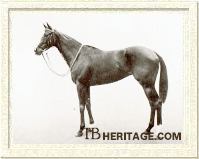
Mrs. Rustom
| |
One of the early stars of this 1931 crop was MRS. RUSTOM (brown filly 1931 out of Cos by Flying Orb), bred by the Aga Khan out of his Champion filly Cos, and thus a younger half-sister to Costaki Pasha and Rustom Pasha. MRS. RUSTOM was a truly brilliant two-year-old and the highweight filly that year, with three wins from five starts including the Dewhurst Stakes, Gimcrack Stakes and Ham Stakes, placing second in the Middle Park Stakes to Medieval Knight. At three, MRS. RUSTOM could not regain her top form, and did not win in six starts, although second in the Peveril of Peak Handicap and third in the King George Stakes and Falmouth Stakes. |
MRS. RUSTOM'S offspring included the juvenile stakes winner Masala (by Stardust) and the useful colt Rustom Sirdar who became the first son of Nearco standing at stud in North America, preceeding Noor and Nasrullah by a few years. Through her daughter, Miss Rustom, MRS. RUSTOM was also ancestress of the Champion English Filly Cormorant Wood. Another daughter, Soga, was the granddam of Australian Leading Sire Better Boy.
Besides the classic winners and champions, there are still more noteworthies from Blandford's remarkable 1931 foal crop. The top class UMIDWAR (bay colt 1931 out of Uganda by Bridaine), bred and raced by the Aga Khan, was a full brother to Blandford's Oaks winner UDAIPUR. A late developer, his only start at two was the Hurst Stakes in November, which he won by a neck. Returning at three, his classic plans were foiled repeatedly. He cast and injured himself in his stall so his training was disrupted. When he started in the 2,000 Guineas, in which he was unplaced behind Colombo, and also injured a hock. UMIDWAR returned in the Derby Stakes, facing a juggernaut in WINDSOR LAD (also by Blandford), and finished unplaced again. Another layoff brought him back to the races in the Eclipse Stakes, and he ran a very good second to the older King Salmon, beating Windsor Lad for the place. Next time out, UMIDWAR won the Gratwicke Stakes over Lo Zingaro, the only other starter. For the St. Leger, UMIDWAR ran fifth behind victorious Windsor Lad, who led in Tiberius and Lo Zingaro. In the Jockey Club Stakes, UMIDWAR beat Lo Zingaro again; and finished the season with a win in the Champion Stakes, beating CAMPANULA, those final two races against very good fields. At four, UMIDWAR was second in the March Stakes (to Easton) and unplaced in the Churchill Stakes. |
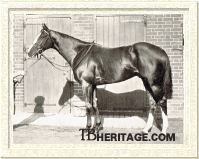
Umidwar

Badruddin
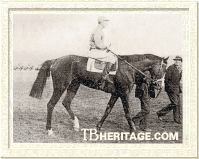
Reine Isaure
| |
A powerfully built horse with a blaze and hind stockings, UMIDWAR proved a good sire, getting the Ascot Gold Cup winner Ujiji, Irish Oaks winner Uvira II, Cheveley Park Stakes winner Keystone, Great Yorkshire Handicap winner Anwar, and the French colt Norseman. His broadest influence, however, comes through two daughters Uvira II and Monsoon II. Through Uvira II comes the American Leading Sires and runners Raja Baba, Plugged Nickle, A.P. Indy, Summer Squall and Lemon Drop Kid. Through Monsoon II came the 1,000 Guineas winner Festoon and the speedy sire Hotfoot.
BADRUDDIN (grey colt 1931 out of Mumtaz Mahal by The Tetrarch) was a rare jewel bred by the Aga Khan out of the great race mare and broodmare Mumtaz Mahal. He was also grey, like his dam, which was a rarity for an offspring of Blandford. BADRUDDIN was a good but not great runner. Stakes-placed at two, he won the Sussex Stakes, Midsummer Stakes, Waterford Stakes and Ormonde Plate at three, placing third in Colombo's 2,000 Guineas. He was unplaced at four.
BADRUDDIN stood two seasons at stud in England then was sold to Argentina where he became an important sire. Before his exportation, he got the good French colt Loliondo and an unraced filly named Perfume II, whose offspring included My Babu, Sayani and Marco Polo. In Argentina, his sons included the Leading Sire Burudun.
The 1931 crop produced three nice fillies, including Oaks-placed ZELINA (bay filly 1931 out of Zoza by Pommern), REINE ISAURE (bay filly 1931 out of Oriane by Sans Souci II), later the dam of Cranach (by Coronach) and most importantly DALMARY (brown filly out of Simon's Shoes by Simon Square), who might be the most influential broodmare of all by Blandford. Winner of the Yorkshire Oaks, she was the dam of a broodmare named Rough Shod II (by Gold Bridge) who was imported by Claiborne Farm in the early 1950s. From Rough Shod II descends the perennial Leading Sires Sadler's Wells, Fairy King, Nureyev, as well as Moccasin, Gamely, Apalachee, Cellini, King Pellinore, Thatch, Topsider and many, many others. |
First Leading Sire Title
The incredible dominance of Blandford's three-year-old runners in 1934 earned him his first Leading Sire title, and his reputation was aided by the two-year-olds in the 1932 crop, which included the Champion Two-Year-Old BAHRAM, the good Irish filly BLANCO and the French colt PUITS D'AMOUR. BAHRAM'S three-year-old exploits and those of many others led Blandford to a second Leading Sire title in 1935, and thanks to the three-year-old filly MISTRESS FORD and four-year-old BRANTÔME, he was also Leading Sire in France in 1935. |

Bahram
| |
BAHRAM (bay colt 1932 out of Friar's Daughter by Friar Marcus) was another Aga Khan homebred, and probably the best of them all by Blandford. A younger half-brother to Irish Derby winner Dastur (by Solario), their dam, Friar's Daughter, was one of the Aga Khan's foundation mares, and was buried with honors at Sheshoon Stud in Ireland when she died in 1951. BAHRAM was a large colt at 16.2 hands, but beautifully conformed, like many of the Blandfords, and oozing class. BAHRAM was the undefeated Champion at two in England, posting five wins starting with the National Breeder'Produce Stakes, won by a neck over another Aga Khan colt, Theft. In the Rous Memorial Stakes, he again won by a neck, then won the prestigious Gimcrack Stakes easily defeating Consequential by a length. In a light field, he won the Boscawen Stakes by three lengths over only two other brave but beaten contenders. He ended the season with a good win over Godolphin and Consequential in the Middle Park Stakes to cap his campaign. |
At three, BAHRAM ran through another undefeated season, although he had a highly respected runner in Bobsleigh to challenge him. In the 2,000 Guineas, Bobsleigh was actually favored but BAHRAM won over Theft and Sea Bequest with Bobsleigh fourth. He won the Derby by two lengths over Robin Goodfellow with Field Trial third, giving his sire Blandford the remarkable fourth victory as a sire in this Blue Riband event. In the St. James's Palace Stakes, he beat Portfolio by a length, but not with his usual power. In the St. Leger Stakes, he won by five lengths to become the first Triple Crown winner since Rock Sand in 1903.
BAHRAM retired to stud in 1936 and was successful but disappointing considering his reputation as a Triple Crown winner. His top runners included Big Game (2,000 Guineas), Turkhan (St. Leger, Irish Derby), Queen of Shiraz (Irish Oaks), and Persian Gulf (Coronation Cup). His important producing daughters included Mah Iran (dam of Migoli) and Queen of Baghdad (dam of Noor). It was a shock when the Aga Khan announced that he had sold BAHRAM to the United Stakes for the 1941 season, and he stood at farms in Maryland and Virginia with little success before he was sent on to Argentina where he died in 1956.
What is surprising is BAHRAM'S influence in perpetuating the Blandford sireline on a global basis. Big Game sired Faux Tirage (a leading sire in New Zealand) and Khorassan (a leading sire in Australia). Persian Gulf sired the South African leading sires Persian Wonder and Abadan. Persian Gulf's son Tamerlane, sired Germany's Leading Sires Alpenkoenig and Dschingis Khan. Dschingis Khan sired another perennial German Leading Sire in Konigsstuhl, who sired Monsun and Monsun sired Samum, also leading sires in Germany. Samum represents the third generation of leading sires and the sixth generation descending in male line from BAHRAM.
Another good one from the 1932 crop was the Coronation Stakes winner ANKARET (bay filly 1932 out of Sister Stella by Friar Marcus), so bred on a similar cross as BAHRAM, who was also out of a mare by Friar Marcus. At three, ANKARET won the Coronation Stakes and was also second in the Oaks by a short head to Quashed. Unfortunately she left nothing as a broodmare. |
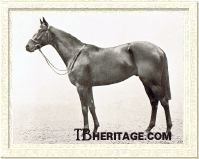
Bala Hissar

Mistress Ford
| |
Blandford's 1933 crop produced several champions and a future leading sire. The first to appear was the Aga Khan's colt BALA HISSAR (bay colt 1933 out of Voleuse by Volta), a big, grand-looking half-brother to the good colt Theft. BALA HISSAR was second in his juvenile debut, the Buckenham Stakes (to Concordat), but won the Dewhurst Stakes at Newmarket. Off that short record, he was the highweight by a pound over another Aga Khan colt, Mahmoud (by BLENHEIM II), and Marcel Boussac's Abjer. At three, BALA HISSAR wasn't competing at the same level. Although favored for the Guineas and the Derby, the rest of the class had passed him, with Pay Up beating Mahmoud by a head in the Guineas, and Mahmoud beating another stablemate Taj Akbar, for the win in the Derby in record time. BALA HISSAR could only score in a minor event at Haydock. He wasn't much of a sire, either, although his daughter Sousse produced the Ascot Gold Cup winner Souepi before being he was sent to Brazil.
In France, Blandford's lovely daughter MISTRESS FORD (bay filly 1933 out of Polly Flinders II by Teddy) dominated her crop, with eight wins in nine starts for her owner, Mlle. Diana Esmond. She was the overall champion at two with wins in the Grand Criterium, Prix Robert Papin, Prix Morny, Prix la Rochette and Prix d'Arenberg. At three, she won the Prix de Diane (French Oaks), Prix Vermeille and her only defeat came when second in the Poule d'Essai des Pouliches (beaten by Blue Bear). |
|
As a broodmare, MISTRESS FORD was also exceptional, producing Eclipse Stakes winner Mystery (by Tehran) and stakes winner Trespass (by Fairway). Her descendants include Barbare, Boitron, Baiser Vole, and 2005 Kentucky Derby winner Giacomo. |
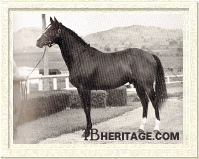
Midstream
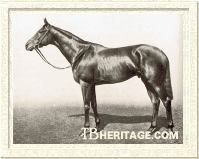
His Grace
| |
Following BLENHEIM II, WINDSOR LAD and BRANTÔME as major sires, MIDSTREAM (bay colt 1933 out of Midsummer; by Abbots Trace) went on to become another son of Blandford who achieved sire success, this time in Australia. One of the better colts of his crop at two with wins in the Boscawen and Criterion Stakes; he was not as effective at three, winning the mile Wykeham Handicap at York, although placing third in the Sussex Stakes in his other races. At four, MIDSTREAM continued in the good miler mode, taking the Newmarket Handicap and Midsummer Handicap, both at eight furlongs, and the Stewards Handicap at six furlongs. This speed bias was unusual for a Blandford horse, which might have given him the edge he needed when sent to Percy Miller's Kia-Ora Stud, New South Wales, Australia in 1938. There MIDSTREAM became the three-time Leading Sire (1947/48, 1950/51 and 1951/52). His top runners included Shannon II, Delta, True Course and Murray Stream before his death in 1957.
A later maturing colt from the same 1933 crop, HIS GRACE (dark bay colt 1933 out of Malva by Charles O'Malley) was a full brother to Derby winner BLENHEIM II, and although his wins included the 1937 Coronation Cup, it was a shared win, in a dead heat with Cecil.
|
|
HIS GRACE was a useful sire and wielded influence through his good daughters Duke's Delight (from which descends Pistol Packer, Saritamer, Rainbow Quest, Commander in Chief, Dushyantor and Warning), York Gala (Prince Royal, Theatrical, Landaluce, Gunner B.), and Bishopscourt (granddam of Kashmir II and Slady Castle). |
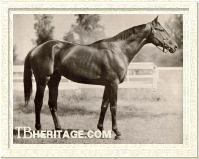
Isolator
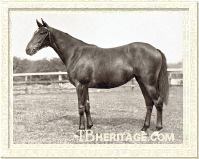
Radiant
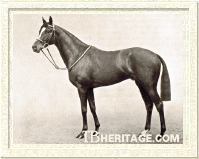
Pasch
| |
America got the benefit of a few Blandfords, too. Besides getting BLENHEIM II as a stallion, William Woodward's English-bred ISOLATER (bay colt 1933 out of Priscilla Carter by *Omar Khayyam) was brought over to race in the U.S. A model of consistency, he was one of the best handicappers at the ages of five, six and seven with wins in the Saratoga Cup, Brooklyn, Merchants' and Citizens', Aqueduct, Manhattan, Gallant Fox, and Rockingham Park Handicaps. ISOLATER entered stud alongside BLENHEIM II at Claiborne Farm in 1941 but could not take advantage of the reflected glory, and wound up as a U.S. Remount stallion in New York.
Blandford's 1935 crop had its own share of stars. RADIANT (bay filly 1935 out of Resplendent by By George!) was a full sister to the great WINDSOR LAD. At two, her wins included the Criterion Stakes and her performances earned her the high weight for her sex. At three, she continued to show her class and was second in the Oaks. Unfortunately, she left nothing behind as a broodmare.
The last major runner sired by Blandford was also his eleventh classic winner, PASCH (bay colt 1935 out of Pasca by Manna). Bred and raced by Henry E. Morriss of the Banstead Manor Stud, PASCH was unraced at two. At three, he ran six times, winning three, including the 2,000 Guineas and Eclipse Stakes, with a third in both the Derby and St. Leger. PASCH retired to Banstead Manor as a four-year-old but died that same year. From that single crop of foals came the unraced mare Pasquinade, dam of the full brothers Royal Palm and Royal Serenade, both champion sprinters in England; Royal Serenade was a good sire in the U.S. Pasquinade also produced the mare Bed O'Roses II, ancestress of the very successful sires Don B. and Verbatim.
|
There was one small crop following PASCH'S, which included stakes winner and Argentine sire DIADOQUE, but that was the end of Blandford's reign. Blandford stood his first season in England at Whatcombe in 1933 but he only made three seasons in his new home. In mid April of 1935, the great stallion contracted a severe case of pneumonia which took him down and out in just two days. He was buried behind the yard at Whatcombe.
Broodmare Influences
Besides the sire influences of BLENHEIM II, BRANTÔME, and BAHRAM, several of Blandford's top racing daughters became important broodmares -- CAMPANULA, DALMARY, MISTRESS FORD, MRS. RUSTOM, REINE ISAURE and UDAIPUR. The most important was probably DALMARY, through her daughter, Rough Shod II who has already been discussed. There are a few other daughters worth noting as well. |
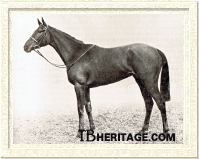
Harina
| |
HARINA (bay filly 1933 out of Athasi by Farasi) was one of the many good ones by Blandford out of William Barnett's blue hen Athasi. A full sister to TRIGO, PRIMERO, HARINERO, ATHFORD and CENTENO; HARINA was also a stakes winner at two but was more important as a broodmare. Her best effort was the stakes winning filly Neocracy (1944 by Nearco), who for the Aga Khan, produced Derby/St. Leger winner Tulyar, Prix de l'Arc de Triomphe winner Saint Crespin III, and stakes winners Bold Nero, Cripton, and Cobetto.
|
WILD VIOLET (1935 out of Wood Violet by Ksar) produced the French runner and sire Wild Risk. Wild Risk inherited the dramatic upright pastern conformation of Blandford, and passed it on to his son Le Fabuleux, who passed it on to his daughter Gana Facil, who passed it on to her great son Unbridled, who passed it on to his son Unbridled's Song. To see this conformation flaw passed along so consistently and through such successful runners and sires just goes to show that racing class and heart often exceeds the physical limitations of the model.
SIMNEL (1932 out of Nicest by Chaucer) produced the 2,000 Guineas winner Lambert Simnel.
LADY SARAH (1932 out of Nancy Stair by Polymelus) was sent to Argentina and produced a daughter, Albikie (by Birikil). Albikie produced champion Niarkos, as well as international stakes winners Psyche II and Zografos.
Stakes-placed LA FURKA (1927 out of Brenta by Sans Souci II) produced stakes winner Chesterfield and the broodmare Terka, dam of French Horse of the Year Tantieme.
MINNEWASKA (1932 out of Nipisiquit by Buchan) produced Grand Prix de Paris winner Avenger II and the filly The Squaw II, who was dam of Cherokee Rose and How; and ancestress of Tom Rolfe, Chieftain, Sham, Ack Ack and Alzao.
SPARKLE (1935 out of Gleam by Galloper Light) was the granddam of Princely Gift.
FUTURITY (1927 out of Dollar Princess by Hapsburg) became the third dam of South African Leading Sire Persian Wonder (by Persian Gulf by BAHRAM, so 3x4 inbred to Blandford).
Blandford's greatness as a sire was unexpected to nearly everyone but the Dawson Brothers, Sam and Richard, who seemed to know what they had the moment they bought him as a yearling. Even though he couldn't make a great racing reputation on the potential he showed as a racehorse, Blandford did not disappoint their faith in him as a stallion. In his day, Blandford was one of the truest sources of classic stamina, and all the crossing to the speedier strains of the times couldn't seem to extinguish that classicity. Blandford's record of siring four Derby winners and three sire championships puts him among the most elite of sires of all time.
-- Anne Peters
|
|
|
|

